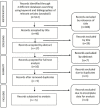Chlamydia Infection as a Risk Factor for Cervical Cancer: A Systematic Review and Meta-Analysis
- PMID: 35865072
- PMCID: PMC9276600
- DOI: 10.18502/ijph.v51i3.8926
Chlamydia Infection as a Risk Factor for Cervical Cancer: A Systematic Review and Meta-Analysis
Abstract
Background: We reviewed studies on the prevalence of Chlamydia infection as a risk factor for developing cervical cancer in a meta-analysis studies published in that subject area.
Methods: Cochrane Library and PubMed databases were systematically searched for articles (observational and randomized controlled trials) published from 2008-2018. A meta-analysis of studies was performed to analyse the association between chlamydia infection and cervical cancer.
Results: Five articles were included in the final analysis (N=5271). All five articles were case-control studies, of which three studies sampled from population-based registries. All studies involved with sexually active women with minimum 15 years old. Three studies reported the association of C. trachomatis infection cervical cancers, two other studies reported C. trachomatis-HPV co-infection in association with cervical cancer. Result showed C. trachomatis has an overall prevalence of 31.9%, pooled OR 1.96, 95% CI 1.05 to 3.67, OR 2.13, 95% CI 1.78 to 2.54 among cervical cancer. There was a mild publication bias detected at 3.0 effect estimation. Heterogeneity detected from clinical and methodological diversities particularly from C. trachomatis-HPV co-infection subgroup analysis, including sampling bias, geographical strain diversity, and different outcome endpoint measured.
Conclusion: C. trachomatis infection was significantly associated with the development of cervical cancer. Co-infection of C. trachomatis-HPV with cervical cancer is plausibly sound but temporality of C. trachomatis-HPV with the development of cervical cancer need to be proven in future prospective cohort studies.
Keywords: Cervical carcinoma; Chlamydia trachomatis; Human papilloma virus; Sexually Transmitted disease.
Copyright © 2022 Pillai et al. Published by Tehran University of Medical Sciences.
Conflict of interest statement
Conflict of interests Non-declared.
Figures
References
-
- World Health Organization (2018). Cervical cancer.World Health Organization. http://www.who.int/cancer/prevention/diagnosis-screening/cervical-cancer... (accessed September 2018).
-
- Azizah AM, Nor Saleha I.T, Noor Hashimah A, et al. (2018). Malaysian national cancer registry report 2007–2011. Putrajaya: National Cancer Institute, Ministry of Health Malaysia; 2015. 228p.https://www.crc.gov.my/wp-content/uploads/documents/report/MNCRRrepor200...
-
- Doll R, Peto R. (1981). The causes of cancer: quantitative estimates of avoidable risks of cancer in the United States today. J Natl Cancer Inst, 66(6):1191–308. - PubMed
-
- Bosch FX, Castellsagué X, Muñoz N, et al. (1996). Male sexual behavior and human papillomavirus DNA: key risk factors for cervical cancer in Spain. J Natl Cancer Inst, 88(15):1060–7. - PubMed
Publication types
LinkOut - more resources
Full Text Sources



